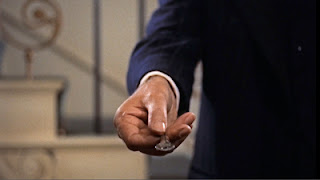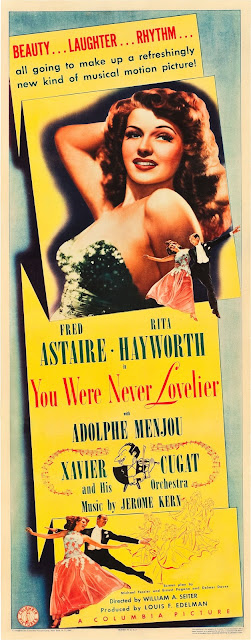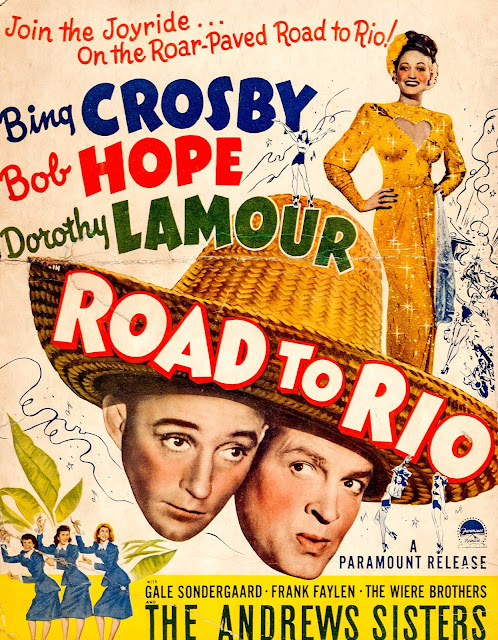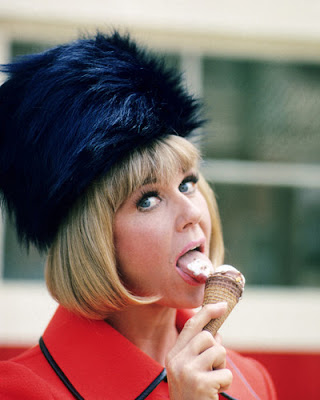"My Letter, Her Stocking, and No Key": Dial M for Murder (1954)
Poster art is fascinating to look at. With just a few images and a few words, it has to tell you what a film is all about. Sometimes it can be disastrous or laughable, thanks to an awful portrayal of what an actor looks like or a cheesy tagline (my favorite: "Baby-faced savage in a jungle of intrigue!" [Born to be Bad, 1950]. Excuse me, what?). Sometimes, though, posters can be just right, such as the one above for Dial M for Murder. Initially, I was confused. Doesn't it look like Grace Kelly is being sexually assaulted and she's trying to call for help? That's not the plot at all!
But then I remembered something Hitchcock once said about how he liked to shoot dangerous or murderous scenes like love scenes, how he enjoyed adding a sexual charge to moments that weren't necessarily about sex. That's when the poster clicked for me, because although Kelly is being strangled and is struggling for her life, that scene has always struck me as highly sensual. Perhaps it was coincidental that the poster artist and the studio went for an eroticized image to titillate the masses, only to accurately depict one of Hitch's deepest themes, or perhaps the artist knew exactly what they were doing. Either way, once you read Alfred Hitchcock's name, you know some craziness is about to go down and we'll enjoy every minute of it.
Well, usually. I'll confess that I wasn't a fan of Dial M when I first saw it. (You can read about that here.) However, once I grew more as a classic film fan and just a film fan in general, I was able to appreciate things much, much more. One of the major reasons why Hitchcock is my favorite director is precisely because of his complex layering. You know that every frame, every shot, every placement of a prop has a meaning. Every piece of the movie has been created and scrutinized long before a single second gets captured on celluloid. And it's all for you and me. Sure, Hitch loved filmmaking, but he loved his audience too. Each picture becomes a neverending gift.
But then I remembered something Hitchcock once said about how he liked to shoot dangerous or murderous scenes like love scenes, how he enjoyed adding a sexual charge to moments that weren't necessarily about sex. That's when the poster clicked for me, because although Kelly is being strangled and is struggling for her life, that scene has always struck me as highly sensual. Perhaps it was coincidental that the poster artist and the studio went for an eroticized image to titillate the masses, only to accurately depict one of Hitch's deepest themes, or perhaps the artist knew exactly what they were doing. Either way, once you read Alfred Hitchcock's name, you know some craziness is about to go down and we'll enjoy every minute of it.
Well, usually. I'll confess that I wasn't a fan of Dial M when I first saw it. (You can read about that here.) However, once I grew more as a classic film fan and just a film fan in general, I was able to appreciate things much, much more. One of the major reasons why Hitchcock is my favorite director is precisely because of his complex layering. You know that every frame, every shot, every placement of a prop has a meaning. Every piece of the movie has been created and scrutinized long before a single second gets captured on celluloid. And it's all for you and me. Sure, Hitch loved filmmaking, but he loved his audience too. Each picture becomes a neverending gift.
With that in mind, naturally there’s a lot to say about Dial M for Murder. It’s a 3-D masterpiece, for one. It’s interesting to me that today 3-D is something Hollywood uses to try to sell big blockbusters, and then you watch Dial M and it’s such a claustrophobic piece with the 3-D process being used to its best advantage. Even Martin Scorsese has said that watching it in its original version was "a revelation." Funnily enough, not many saw this version when it was released in 1954. 3-D had been all the rage in 1953, when Dial M was in production, but by the time it got to theaters, the craze was ending and most theaters received the 2-D version. I have a long list of films I want to watch on the big screen, but seeing Dial M in 3-D is near the top.
What surprises me is that Warner Brothers decided to hop on the 3-D wagon with this property, which originated as a stage play by Frederick Knott and is basically confined to one setting, the Wendices' London flat. It's not like, say, Kiss Me, Kate where you can have Ann Miller throwing gloves at the screen or Tommy Rall swinging into the camera/the audience. But thankfully, Warner Bros. knew what they were doing when they handed the project to Hitchcock. Even though I've only seen the "flat" version of this film, as I'm sure many of you have,
you have to carefully look at the mise-en-scene in order to get a taste of what Hitch was trying to accomplish with the 3-D process. Lamps, tables, and other furniture are frequently placed between the camera and the actors (unobtrusively, of course), adding depth to the set and putting the viewer right there with them, something you couldn't do watching it on the stage. More importantly, significant things reach out of the screen, like the multiple keys and Grace Kelly's hand searching for the scissors.
The film opens with something I never noticed until my last viewing: Tony knocks over a salt shaker at the breakfast table and throws the spilled salt over his shoulder for luck. It’s so subtle and you don’t think much of it until you realize that he already has the plan to murder Margot in his mind, therefore he tries to turn a sign of bad luck (spilling salt) into good luck (throwing it over his shoulder). You have to love Hitch’s humor, which only accumulates during the film. For instance, the film opens with a shot of a policeman outside of the Wendices' building. His presence proves useless because everything sinister is happening inside, emphasizing the idea that we don't know what goes on behind closed doors.
The most obvious pieces of humor and irony come from Mark's profession as a mystery writer. In one scene, Tony slyly questions him about his writing process and his stories. Mark prophesizes Tony's downfall, jokingly saying if he committed a murder in real life, "I'd make some stupid mistake and never realize it until I found out everybody was looking at me." Later, after Margot is found guilty of killing Swann, Mark tries to convince Tony to take the blame and save Margot, but he doesn’t realize that the fake motive he gives to Tony is what actually happened. One of the more subtle cases of irony is that Tony's plan fails because of his suggestion to Margot that she stay home and finish scrapbooking his clippings; ultimately, he became too clever for his own good.
What interests me most about Dial M is Tony. He is the epitome of the quiet, cool murderer, played to perfection by Ray Milland. His best scene may just be when he is revealing his wicked ways to Swann, at one point the material feeling like a play within a play as Tony fully presents his true self for the first time in the film. He lies to get Swann to his apartment, but once he drops the pretenses, we get to really see Tony and it ain't pretty. Jealous, petty, greedy, and oh yeah, homicidal, the ex-tennis star becomes our villain in this moment. Although he doesn't go with Margot and Mark to a play that night, he stages his own performance with Swann, who becomes an entranced audience member just like us. He can't help but watch and listen to Tony, despite feeling uneasy about the situation. He wants to leave, but he also wants to stay, to study Tony, and to understand what he is up to and why.
While we identify with Swann, we also become complicit with Tony as we silently beg Swann to keep talking with him because we need all of this information to believe in the story and also because we want to see how this plan will go down. There are even a few instances where the camera aligns us with Tony, such as when Swann looks right into the camera, which is positioned where Tony is sitting, or when the camera assumes his point of view as he phones the police about the murder. The policeman asks who the killer is and when Tony glances at Margot, getting the idea to frame her, the camera becomes him for a few seconds.
That's what is morbid about this film. I mean, my favorite part is when Margot is attacked, a statement that sounds horrid and would probably make Hitch chuckle. It's just filmed so marvelously, from the silhouette of Grace Kelly in the doorway to the cross-cutting to the camera circling around Margot as she answers the phone to the fatal struggle between her and Swann. The lighting and cinematography is superb, with the glow of the fireplace creating flickering light and shadows. Out of the 36-day shooting schedule, Hitchcock spent a week on this
sequence and reportedly lost twenty pounds from the anxiety of it. Making the process more difficult was the 3-D camera, which was enormous and couldn't achieve certain angles. Hitch's perfectionist attitude exacerbated matters, although Kelly stated that he never lost his patience or his temper. Always ready with a dry quip, after multiple takes of the murder, the director said, "This is nicely done but there wasn't enough gleam to the scissors, and a murder without gleaming scissors is like asparagus without the hollandaise sauce -- tasteless."
Dial M is essentially about a love triangle, with one part of the triangle not handling it very well. Tony frequently finds ways to get revenge on his wife for straying, although for most of the film, she and Mark remain unaware that it is Tony behind the machinations and not just some cruel fate. For one thing, Tony uses Mark for his alibi the night of Margot's attack. He also loves to point out to Mark after the trial that the jury's verdict was probably his fault: "It's because of her association with you that she lost the sympathy of the jury." Mark thinks he is right, not realizing that Tony's careful frame job did a pretty damn good job without the help of Mark's love letter.
 |
| from Giphy |
The film is mainly composed of a somewhat bland color scheme, where unexciting shades of blue, brown, gray, and green often fill the screen. Because of this, the pops of color he includes stick out and make you pay attention. Curiously enough, these bright flashes always seem to be attached to Margot. The red dress she wears in her first scene with Mark is obvious in its implications of her being a "lady in red" for having an affair, and also in its
foreshadowing of the blood to come at her hands (literally). However, the shockingly red dress embodies Margot's inner feelings as well. It goes back to Hitchcock's idea of the "cool blonde," the woman who looks cold and glacial but is actually a tigress on the inside. Kelly is often considered the absolute ideal Hitchcock blonde, and Margot is an example why. She might be the quiet and demure housewife in soft pink, giving her husband a chaste kiss when we initially see her, but Hitch cleverly and silently contrasts that image with the very next one: Margot in lacy red, passionately kissing her lover. The more she talks about her marriage and the problems that drove her to Mark, the more apparent it becomes that she feels more comfortable with him, perhaps even more alive. (Pun not intended, but still hilarious.) You can watch this scene here.
The other major instance of color is when Margot goes through her trial. Instead of taking us to a courtroom and diluting the story with another setting and more characters, Hitchcock simply has Kelly stand in front of the camera and react to what Margot hears, with the blank background changing colors as her situation becomes more dire. Hitch wanted to stick as close as possible to the original play, but he also added touches that made you aware that it was still cinema. Fluid camera movements,
high and slanted angles, lots of shot/reverse shot when people are talking, and close-ups help distinguish it from what you would see on the stage. It would have been easy to film some moments from a wide angle that encompasses all of the characters in the scene, like when Tony throws some money to Swann, but instead Hitch does things with a little flourish, making the camera pan from Tony to Swann as it follows the money that goes flying through the air.
I think this idea of breaking up the potential monotony of the action is part of why Hitchcock continually cuts to Margot doing trivial things while Tony is setting her up for murder in the next room. Watching her get a glass of water or sitting on her bed feels unimportant, but it occurred to me that it's Hitch's way of checking in with Margot after this traumatic event. She is trying to keep herself together, clueless that this is her husband's fault. The fact that she is isolated makes it all the more devastating. In the previous scene, when Tony tries to get her to stay home by reminding her of her weekly radio program, she says she doesn't want to listen to it tonight because "it's a thriller. I don't like thrillers when I'm alone." Now she has been thrust into her very own thriller, and Tony forces her to deal with it virtually by herself.
Amazingly enough, I think I've just scratched the surface of this film. I could easily spend a month digging into the complexities of it, and hopefully you'll share your own thoughts with me in the comments below! And if you haven't seen Dial M yet, I hope my post has inspired you to check it out!
With love,
Michaela
********************************************
I'm happy to say that this is my contribution to the Alfred Hitchcock Blogathon, a deserved celebration of the Master for his 117th birthday. You can (and should!) read the other tributes here.
























Wow. I loved reading this post! It was thoughtful and interesting and it made me think of Dial M in many new ways...Hitchcock's little touches and symbolism and subtle humor are the BEST, aren't they? :) Reading analytical posts like this is a favorite past-time, though I'm usually too lazy to write one of them myself. :P
ReplyDeleteNow I want to watch Dial M again!
~Eva
Thank you! I know what you mean. I love to write this kind of post, but I often don't have the time or I'm feeling too lazy. Luckily, with Hitchcock, it's easy for me to put my scholarly thinking cap on. You know everything has been picked for a certain reason, so you've just gotta figure out the answer.
DeleteThis is such an excellent analysis. I was so engrossed and the way you explained the technical aspects was just wonderful. I've always loved the red dress Margot wears but hadn't thought much of the symbolism. Also!! The trial scene was always one of those scenes that fascinated me when I first saw it. I didn't know much about film and I was just getting into Hitch but I thought it was really intriguing.
ReplyDeletePS: I totally forgot Robert Cummings played her lover.
Poor Bob Cummings. He was often given bland roles, making him somewhat forgettable, but I always enjoy him. He did an episode of I Love Lucy in its last season that is pretty hilarious. I heard somewhere that Hitchcock made the role of the lover a little boring so the comparison between him and Milland would be much greater. I haven't read the original Knott play, so I'm not sure if this is true or not.
DeleteI love that dress, too! I enjoy all of her clothes in this film, but I often wish they were in different colors. Hitch purposely made the clothes progressively somber to reflect Margot's dire state, so cinematically it makes sense but personally, I wish they were brighter.
Thanks for the comment, Simoa! I'm always hoping to do think pieces like this but seldom come through, so it's nice to hear that someone enjoys it!
Love Dial M! And that was a brilliant analysis Michaela! I especially liked what you said about the poster at the beginning. The "murder" scene is my favourite one from an Hitchcock film. I had the chance to see this film twice on big screen, including once in 3D. However, I must admit I was a bit disappointed by this last one. I mean, it's visually very impressive for the murder scene,but for the rest it's not very relevant. I mean, most of the time it's mostly people standing and speaking. The fact that it's in 2D or 3D doesn't change anything really... And I have to say, 3D glasses annoy me so much!
ReplyDeleteI'm not a big fan of 3-D, either, usually because it seems so silly. I'd still enjoy seeing that scene of Margot and Swann the way it was intended, though.
DeleteThanks for reading, Virginie! I'm hoping to read the other posts, including yours, today!
I’m not sure why Tony burns the scarf. Is he trying to make it look like she inflicted the wounds and there was no murder attempt by Swan?
ReplyDeleteI had to Google about the scarf being burnt & stockings planted too .
DeleteIt ultimately brought me here. Yes it was to frame Margo to make it look like she made the marks on her throat. I just watched it again tonight probably for my 50th time and I really enjoyed the analysis above. I would actually like to see it in 3D just for the experience. One of Hitchcocks best films and the entire cast selection really brings the directors vision to life.